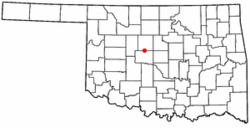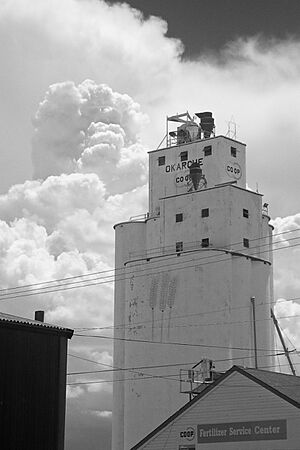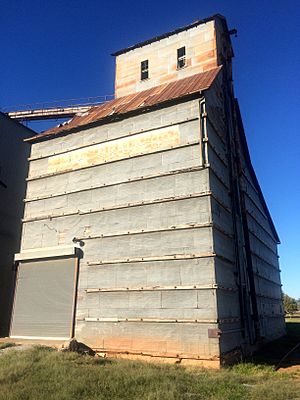Okarche, Oklahoma facts for kids
Quick facts for kids
Okarche, Oklahoma
|
|
|---|---|

Location of Okarche, Oklahoma
|
|
| Country | United States |
| State | Oklahoma |
| Counties | Kingfisher, Canadian |
| Area | |
| • Total | 2.24 sq mi (5.81 km2) |
| • Land | 2.20 sq mi (5.70 km2) |
| • Water | 0.04 sq mi (0.11 km2) |
| Elevation | 1,240 ft (380 m) |
| Population
(2020)
|
|
| • Total | 1,141 |
| • Density | 518.64/sq mi (200.22/km2) |
| Time zone | UTC-6 (Central (CST)) |
| • Summer (DST) | UTC-5 (CDT) |
| ZIP code |
73762
|
| Area code(s) | 405/572 |
| FIPS code | 40-54050 |
| GNIS feature ID | 2413074 |
Okarche (pronounced oh-KAR-chee) is a town in Oklahoma, United States. It is located in both Canadian and Kingfisher counties. Okarche is also part of the larger Oklahoma City Metropolitan Area. In 2020, about 1,141 people lived in Okarche.
Contents
History of Okarche
Okarche is built on land that was once home to the Wichita people before 1830. Later, in 1830, this area became part of the territory given to the Creek and Seminole tribes. These tribes were moved from the southeastern United States. After the American Civil War, some parts of Indian Territory were set aside for Plains Indians. The future town of Okarche was just inside the eastern edge of the Cheyenne and Arapaho reservation.
Cattle Trails and Railroads
From 1867 to 1884, cowboys herded cattle through this area. They used the Chisholm Trail to move cattle from Texas to train stations in Kansas. Later, the Chicago, Rock Island and Pacific Railroad and a main road (now U.S. Highway 81) followed a similar path.
On March 2, 1887, the U.S. Congress allowed a railroad to be built through Indian Territory. The Chicago, Kansas and Nebraska Railway got permission to build a track 100 feet wide. They could also take more land for train stations every 10 miles. This railway later became part of the CRI&P in 1890. The railroad was finished in the Okarche area by January 1890. The train station for Okarche was built around that time.
Town's Founding and Growth
The Okarche post office opened on June 28, 1890. The lands of the Cheyenne and Arapaho tribes were opened for settlement on April 19, 1892. This was done through a special event called a land run. Okarche officially became a town in 1905, two years before Oklahoma became a state.
The name Okarche comes from parts of three words: Oklahoma, Arapaho, and Cheyenne. The Southern Arapaho and Cheyenne Native American tribes had moved to Oklahoma in the late 1800s. For many years after statehood, the town's population stayed around 400 people. By 2010, it had grown to over 1,200 residents.
German Heritage in Okarche
By the late 1890s, many German immigrants lived in Okarche. The German language was widely spoken in the community. Many of these immigrants had come to America in the 1880s. They often lived in states like Iowa, Nebraska, or Missouri before moving to Oklahoma.
Catholic and Lutheran churches and schools were built. This helped immigrants keep their faith and traditions alive. St. John's Lutheran Church started in 1892, and Holy Trinity Catholic Church began in 1893. Services and classes were mostly in German until 1917, when the United States entered World War I. Bilingual services continued for about 20 more years.
Modern Roads and Transportation
In November 1926, the main road through Okarche became US-81. It was fully paved in the Okarche area by 1931. The Northwest Highway (OK-3) opened as a gravel road in 1939 and was fully paved by 1947. Today, Okarche has four-lane highways connecting it to nearby towns and the Oklahoma City area. The original Rock Island railroad route is now operated by the Union Pacific Railroad.
Geography of Okarche
Okarche is located right on the border between Kingfisher and Canadian counties. U.S. Route 81 goes south 14 miles to El Reno. It also goes north 10 miles to Kingfisher. Oklahoma State Highway 3 goes southeast 34 miles to Oklahoma City.
The United States Census Bureau says Okarche covers a total area of about 2.24 square miles (5.81 square kilometers). A very small part of this area, about 0.04 square miles (0.11 square kilometers), is water.
Population and People
| Historical population | |||
|---|---|---|---|
| Census | Pop. | %± | |
| 1910 | 402 | — | |
| 1920 | 449 | 11.7% | |
| 1930 | 482 | 7.3% | |
| 1940 | 453 | −6.0% | |
| 1950 | 532 | 17.4% | |
| 1960 | 584 | 9.8% | |
| 1970 | 826 | 41.4% | |
| 1980 | 1,000 | 21.1% | |
| 1990 | 1,160 | 16.0% | |
| 2000 | 1,110 | −4.3% | |
| 2010 | 1,215 | 9.5% | |
| 2020 | 1,141 | −6.1% | |
In 2010, there were 1,215 people living in Okarche. There were 468 households and 321 families. Most of the people (92.8%) were White. Other groups included African American (0.6%), Native American (2.3%), and people of Hispanic or Latino background (5.4%).
About 28.2% of households had children under 18. Most households (57.3%) were married couples. The average household had 2.40 people, and the average family had 2.99 people.
The population's age groups were:
- 22.9% under 18 years old
- 5.9% from 18 to 24 years old
- 24.9% from 25 to 44 years old
- 28.7% from 45 to 64 years old
- 17.6% were 65 years or older
The average age in Okarche was 41.8 years.
Economy and Local Businesses
Okarche is well-known for Eischen's Bar. This place claims to be the oldest bar in Oklahoma. It is famous for its special recipe fried chicken. In 2009, the TV show Diners, Drive-Ins and Dives on Food Network visited Eischen's.
The town was also used as a place to film scenes for the movie "Twisters". This film is a sequel to the 1996 movie "Twister".
Major employers in Okarche include Nortek (formerly Temtrol). This company makes air handling units, coils, and fans. Another important employer is OEM Systems. This company specializes in fitting custom equipment into commercial vehicles. They also convert vehicles to run on compressed natural gas.
Notable People from Okarche
- Brooks Douglass: An American actor, film producer, lawyer, and Oklahoma state senator.
- Daniel Henry Mueggenborg: A Roman Catholic bishop.
- Stanley Rother: A Roman Catholic priest who is considered a candidate for sainthood.
- Chris Schroder: A right-handed baseball pitcher who played for the Washington Nationals.
See also
 In Spanish: Okarche (Oklahoma) para niños
In Spanish: Okarche (Oklahoma) para niños



